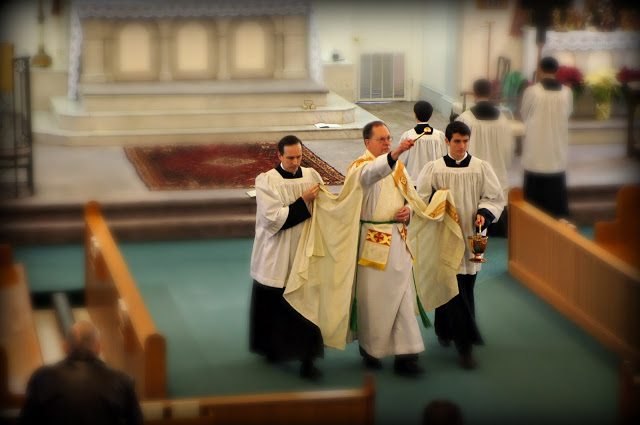 |
| Altar of Sacrifice |
Before we begin reflecting and meditating on the Liturgy of the Catechumens (a.k.a. Liturgy of the Word), I wanted to kind of summarize in more detail the symbolism of the actions of the priests and the servers, as well as consolidate what we've reflected on so far into a main thesis.
Ascending the Mountain of Sacrifice
In the Old Testament, the mountain is symbolic of so many things. Moses received the Ten Commandments on a Mountain. Moses also commanded a battle on a mountain. Elijah observed God on the mountain. Abraham and Isaac ascended the mountain for the sacrifice.
These are types, which are fulfilled in the New Testament. Our Lord gives the New Law at the Sermon on the Mount. A mountain is where He is transfigured, and a mountain is also where He prays in his agony. He is also crucified on a mountain. Even the Holy Spirit descends on the Apostles and Our Lady in an "upper" room. The Church itself is a city on the hill! (cf Matthew 5:14).
The Old Testament types were not lost on the Jews. When sacrificing a goat or lamb, the altar was raised very high (in fact, I believe it was about ten to twenty feet above everything else). It was a place where something was consumed. In fact, worship is defined as offering something that is consumed and lost, in order to please God, and from which nothing is salvageable for man's use. (Ordinary sacrifices that we make every day become true, perfect sacrifices when we completely relinquish something in faith and love and thus do not have anything left over or that can be taken back for further use.)
Because the Catholic liturgies take so much from the early Jewish liturgy, it is no wonder that altars have for the vast majority of the Church, until recent times, been raised higher than all by several steps. This symbolizes all of which I mentioned above, because all of these things, even the Old Testament types in the past, flow out of the sacrifice on the Cross, which is represented on the altar in the Mass.
We Look For the Resurrection of the Body...
The altars are even situated so that the priest offers the Mass facing east. The Jewish sacrifice also faced east, which the Church maintained primarily throughout most of its history. This essential posture was changed by a lot of Protestants in their revolutions, such as Thomas Cranmer. Facing east or ad orientem was so integral to the concept of the sacrifice that Thomas Cranmer faced the people in order to undermine the sacrificial belief in the Mass.
Facing east also symbolizes the anticipation of Our Lord descending upon the clouds from the east. It is also fitting that, since the sun rises in the east, we perceive the true light as coming from the east. This idea makes it especially crucial because, with the priest and all the people facing east, they are explicitly open to God. Otherwise, things become a closed circle. We never want to be closed to God, content in our own ways, eating without Him.
In fact, the Apostles and Our Lord even faced ad orientem at the Last Supper! The tables of that time were such that, being situated somewhat in a "U" shape, all the participants faced the same direction. This allowed servers to come directly to the diners and bring them things. How beautiful that this is seen in the liturgy, when the priest and people face the same direction, towards God, and He sends his angels to minister to them!
The Sacrifice of Hands
The priest places his hands together in front of him very frequently, such as immediately after crossing himself, when bowing in prayer, etc. This positions shows that the priests hands are consecrated for offering a sacrifice, and thus are themselves a sacrifice (priests don't have other jobs, for example). It also shows a willingness to offer our hands to God. This is why the laity traditionally prays with their hands in front and together, rather than folded at the lap, or in the orans position (hands up while praying).
Summary of the Mass to this point
We can summarize the prayers of the Mass, and their meaning--from the Asperges to before the introit--in the following way.
Lord, I am unworthy to approach you, but let me come properly to you through your protecting grace. Lord, wash me with the water that flows out of your side, from your very being, and cleanse me. I am afflicted from all sides, from within and without. Send your angels to me. Hear my humility and forgive me my sins, and then draw me into your very home. Show me the way to you.














